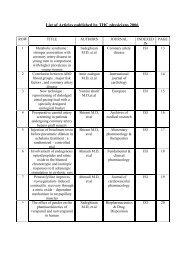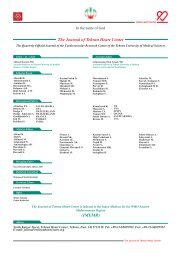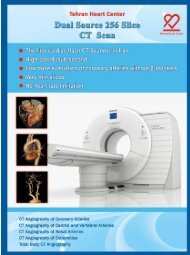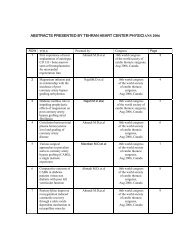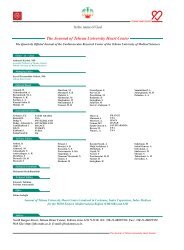Journal of Tehran University Heart Center
Journal of Tehran University Heart Center
Journal of Tehran University Heart Center
Create successful ePaper yourself
Turn your PDF publications into a flip-book with our unique Google optimized e-Paper software.
Incidental Finding <strong>of</strong> Cor Triatriatum Sinistrum in a Middle-Aged Man ...<br />
Figure 4. Doppler flow imaging across the membrane orifice (transesophageal<br />
echocardiography (view)<br />
Figure 5. Macroscopic view <strong>of</strong> the removed left atrial membrane from the<br />
pulmonic veins aspect (5.5 × 4 cm)<br />
slight male predominance involvement (1.4:1) and is<br />
associated with other cardiac defects in up to 50% <strong>of</strong> cases.<br />
Examples <strong>of</strong> associated cardiac defects include atrial septal<br />
defect, persistent left superior vena cava, partial anomalous<br />
pulmonary venous connections, ventricular septal defect,<br />
and more complex cardiac lesions such as the tetralogy <strong>of</strong><br />
Fallot, atrioventricular septal defect and double outlet right<br />
ventricle.<br />
In its most common form <strong>of</strong> cor triatriatum sinistrum, the<br />
left atrium is divided into proximal and distal chambers.<br />
Both chambers are separated by a diaphragm with one or<br />
more restrictive ostia, with the pulmonary veins draining into<br />
the proximal chamber. The location <strong>of</strong> the atrial appendage<br />
is a key landmark in this congenital malformation: In cor<br />
triatriatum, the atrial appendage is invariably connected with<br />
the lower chamber, which is below the membrane.³<br />
When the atrial septal defect exists between the left atrial<br />
TEHRAN HEART CENTER<br />
accessory chamber and the right atrium, the patients refer<br />
to hospital with symptoms <strong>of</strong> associated elevated pulmonary<br />
venous and arterial pressures because blood is shunted from<br />
left to right 3, 4 In our case, the patient only had a history <strong>of</strong><br />
dyspnea on exertion and there was no evidence <strong>of</strong> intracardiac<br />
shunt.<br />
The primary concern with cor triatriatum sinistrum is<br />
the potential for the left ventricle inlet obstruction, leading<br />
to mitral stenosis physiology. It is deserving <strong>of</strong> note that<br />
the pulmonary venous inflow can be compromised, albeit<br />
rarely, 5 but there was no evidence <strong>of</strong> the left ventricle inlet<br />
obstruction in our patient. The chest radiograph usually<br />
shows increased vascular markings, and a cardiac murmur<br />
is frequently noted. Be that as it may, with cor triatriatum<br />
sinistrum, the apical diastolic rumble <strong>of</strong> mitral stenosis<br />
is generally absent. Some patients with cor triatriatum<br />
sinistrum may remain asymptomatic, whereas others may<br />
have late onset <strong>of</strong> symptoms, which is possibly related to the<br />
fibrosis and calcification <strong>of</strong> the membrane with associated<br />
atrial fibrillation or mitral regurgitation. 6<br />
ECG findings are non-specific, but may reveal right-axis<br />
deviation with right atrial and right ventricular hypertrophy<br />
and atrial arrhythmia in some patients. Echocardiography is<br />
<strong>of</strong>ten sufficient for the diagnosis and TEE is the diagnostic<br />
modality <strong>of</strong> choice. Three-D echocardiography is also a new<br />
modality for the diagnosis and enjoys high accuracy. 7-10 The<br />
only treatment is surgical correction, and the majority <strong>of</strong><br />
postoperative deaths occur in the first 30 days. In the early<br />
surgical series, the mortality was as high as 15-20% but<br />
more recently the rates have reached as low as 2%. 11, 12 Longterm<br />
results are excellent, with survival rates <strong>of</strong> 80-90% in<br />
patients surviving surgery. 11-14 Our patient also underwent a<br />
successful surgical operation and he was well at the firstmonth<br />
follow-up.<br />
References<br />
1. Niwayama G. Cor triatriatum. Am <strong>Heart</strong> J 1960;59:291-317.<br />
2. Jorgensen CR, Ferlic RM, Varco RL, Lillehei CW, Eliot RS. Cor<br />
triatriatum. Review <strong>of</strong> the surgical aspects with a follow-up report<br />
on the first patient successfully treated with surgery. Circulation<br />
1967;36:101-107.<br />
3. Marín-García J, Tandon R, Lucas RV Jr, Edwards JE. Cor<br />
triatriatum: study <strong>of</strong> 20 cases. Am J Cardiol 1975;35:59-66.<br />
4. Oglietti J, Cooley DA, Izquierdo JP, Ventemiglia R, Muasher I,<br />
Hallman GL, Reul GJ, Jr. Cor triatriatum: operative results in 25<br />
patients. Ann Thorac Surg 1983;35:415-420.<br />
5. Melnick AH, Brzezinski M, Mark JB. Incidental cor triatriatum<br />
sinister during coronary artery bypass surgery. Anesth Analg<br />
2005;101:637-638.<br />
6. Chen Q, Guhathakurta S, Vadalapali G, Nalladaru Z, Easthope RN,<br />
Sharma AK. Cor triatriatum in adults: three new cases and a brief<br />
review. Tex <strong>Heart</strong> Inst J 1999;26:206-210.<br />
7. Schluter M, Langenstein BA, Their W. Transesophageal twodimensional<br />
echocardiography in the diagnosis <strong>of</strong> cor triatriatum<br />
in the adult. J Am Coll Cardiol 1983;2:1011-1015.<br />
8. Tantibhedhyangkul W, Godoy I, Karp R, Lang RM. Cor triatriatum<br />
The <strong>Journal</strong> <strong>of</strong> <strong>Tehran</strong> <strong>University</strong> <strong>Heart</strong> <strong>Center</strong>87



